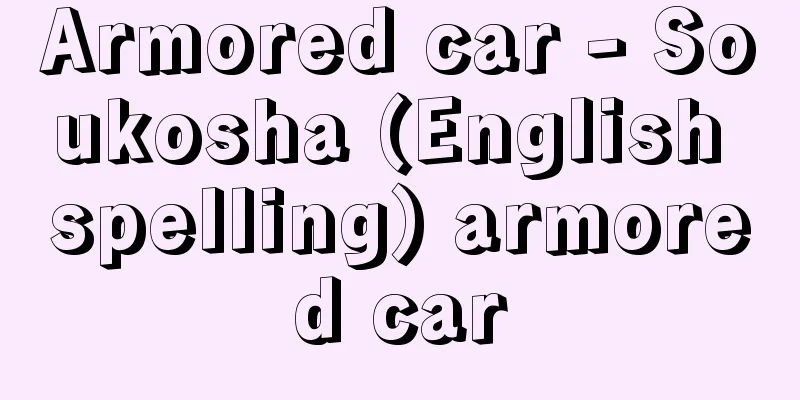Armored car - Soukosha (English spelling) armored car

|
It is a combat vehicle with less firepower and protection than a tank, and is mainly used for troop transport, reconnaissance, command, and vehicle combat by infantry. There are three types based on the running gear: tracked (caterpillar), wheeled (tired), and half-track (half-track type with tires on the front wheels and tracks on the rear wheels), and in the past there were also tracked and wheeled types. Wheeled armored cars appeared earlier than tanks, and their prototypes were seen at the end of the 19th century, but they did not see full-scale development until World War I, when they were used mainly for reconnaissance and surveillance, taking advantage of their high speed on the roads. Because their operation is highly dependent on the development of road networks, wheeled armored cars have been developed mainly in European countries. The first tracked armored car was the Type IX, made in the UK in 1918, which could transport 50 soldiers, but it was only after World War II that the armored personnel carrier was put into focus as a means of protecting infantry from the threat of nuclear weapons while at the same time increasing their mobility. In recent years, more heavily armed and armored infantry fighting vehicles have appeared as an advanced version of this type, designed for on-board infantry combat, and are also used as platforms for various weapons such as missiles. Half-tracked armored cars were used in large quantities by the German army from the beginning of World War II, and by the US army in the latter half of the war, for transporting soldiers, but while they have the advantages of both wheeled and tracked cars, they also have disadvantages, making them prone to being half-baked, and are not used much today. Mechanically, they are similar to tanks, and are used for military purposes as well as police purposes for security and patrol. [Akira Takeuchi] [Reference] |Armored vehicle of the Japan Ground Self-Defense Force. Overall length 6.84m, overall width 2.48m, overall height 1.85m, total weight approximately 14.5t, maximum speed approximately 100km/h. Type 96 40mm automatic grenade launcher or 12.7mm heavy machine gun ©Shogakukan "> Type 96 Wheeled Armored Car Source: Shogakukan Encyclopedia Nipponica About Encyclopedia Nipponica Information | Legend |
|
戦車に比較して軽度の火力、防護力をもつ戦闘用車両で、おもに兵員輸送、偵察、指揮、歩兵の車上戦闘などに使用される。走行装置の違いにより装軌式(キャタピラー)、装輪式(タイヤ)、半装軌式(前輪タイヤ、後輪装軌のハーフトラック式)の3種類があり、過去には装軌装輪併用式もあった。装輪式装甲車(装甲自動車)の出現は戦車よりも早く、19世紀末にはその原型がみられるが、本格的な発展をみたのは第一次世界大戦においてであり、路上での高速力を利用して、とくに偵察、警戒などの任務に多用された。運用が道路網の整備に依存する度合いが大きい関係上、装輪装甲車はおもにヨーロッパ諸国を中心に発達してきた。装軌式装甲車としては、1918年にイギリスでつくられたⅨ号型が最初で、50人の兵員を輸送できたが、長足の進歩をみたのは第二次大戦後で、核兵器の脅威から歩兵を防護すると同時に、その機動性を高めるために装甲兵員輸送車がクローズアップされた結果による。最近ではその発展型として、歩兵の車上戦闘を目的とした、より重武装重装甲の歩兵戦闘車も出現し、またミサイルなど各種兵器のプラットフォームとしても使用されている。半装軌式装甲車は第二次大戦初頭からドイツ軍が、また後半にはアメリカ軍が兵員輸送用として大量に使用したが、装輪式と装軌式の長所をもつ反面、短所もあわせもつため中途半端な性格に陥りやすく、現在ではあまり使われていない。機構的には戦車に準じており、軍用のほか警察用として治安、警備などにも使用される。 [竹内 昭] [参照項目] |陸上自衛隊の装甲車。全長6.84m、全幅2.48m、全高1.85m、全備重量約14.5t、最高速度約100km/h。96式40mm自動擲弾銃または12.7mm重機関銃©Shogakukan"> 96式装輪装甲車 出典 小学館 日本大百科全書(ニッポニカ)日本大百科全書(ニッポニカ)について 情報 | 凡例 |
>>: General magazine - Sougouzasshi
Recommend
Goto Makita - Goto Makita
A science education leader during the Meiji and T...
Solana - Sora-na (English spelling) José Gutiérrez Solana
Spanish painter and writer. Born and died in Madr...
Goldschmidt, R.
...There is also no consensus as to whether this ...
Wang Shizhen - Wang Shizhen
A poet of the Qing dynasty in China. His real nam...
Clethrionomys rutilus mikado (English spelling) Clethrionomysrutilusmikado
…[Tadaaki Imaizumi] [Yoshinori Imaizumi]. … *Some...
Red Hawaiian Honeyeater - Red Hawaiian Honeyeater
... Hawaiian honeycreepers prefer tropical rainfo...
Shel-Acheulean culture
During the Middle Pleistocene, the Early Paleolith...
attitude director indicator
…Typical examples are the attitude director indic...
Transduction - transduction
The transfer of genetic information to another cel...
Congenital syphilis
Syphilis is transmitted from the mother through th...
Image intensifier
A vacuum tube that accelerates and focuses photoel...
Enya Okihisa
...A medieval samurai family in Izumo. A branch o...
Wystan Hugh Auden
A poet born in England, who later became a natura...
Sewa [village] - Seiwa
A village in Taki County, central Mie Prefecture. ...
Sea ant - Sea ant
...Although a considerable population did gather ...




![Osaka [city] - Osaka](/upload/images/67cb151e12a00.webp)




